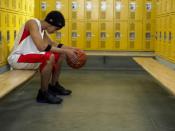Many parents and coaches of gifted child athletes entertain dreams of Olympic gold for their young charges. But prudence needs to be taken with elite child athletes, said Walter R. Thompson, Ph.D., FACSM, during a session at the 55th Annual Meeting of the American College of Sports Medicine in Indianapolis in May 2008.
Thompson, an ACSM-certified Program Director ℠ and ACSM Registered Clinical Exercise Physiologist® and member of the International Paralympic Committee, chaired a symposium on special circumstances and needs related to both able-bodied and physically disabled child athletes. The symposium addressed issues of training, competition, injury prevention, and rehabilitation related to child Olympians and Paralympians.
"The focus has to be first and foremost on the wellbeing of the child," said Thompson.
Parents and coaches must continually evaluate what is in the best interest of the child. For parents, this means paying attention to what the child wants, but also taking responsibility to protect the child from overtraining and excessive demands. Time needed for training in a sport can be significant for an elite athlete.
"This can create both physical and psychological pressures," said Thompson. "One sign that a child is being pushed too hard or too far is when they start to say things like they don't want to go to practice or they want to quit their sport. If this type of feedback from a child becomes persistent, parents need to listen, and take a step back to consider what is best for the child."
In addition to the psychological pressure that might be placed on a child who is engaged in a sport at an elite level, the child needs to be protected from physical injury. And if the child is injured, coaches and parents have to be sure there is appropriate rehabilitation to promote healing and to prevent re-injury.
"Catastrophic injury can usually be prevented if coaches pay attention to what is happening with a child athlete during a training session," said Thompson. "Some kids train six or seven hours a day. Coaches need to be sure the children are getting proper rest, and also that they have proper nutrition." He notes that good nutrition is important in injury prevention, as it can help build and maintain healthy bones and muscles.
Child athletes are especially vulnerable to growth plate injury. The growth plate is the area of growing tissue near the ends of the long bones in children and adolescents. Because growth plates are the weakest areas of the growing skeleton - even weaker than the nearby ligaments and tendons that connect bones to other bones and muscles - they are vulnerable to injury. Growth plate injuries can be caused by an event such as a fall or blow to the limb, or they can result from overuse. For example, a gymnast who practices for hours on the uneven bars, a long-distance runner, or a baseball pitcher perfecting his curve ball can all develop growth plate injuries.
One major issue that health and sports professionals are grappling with is if there are appropriate ages for participation in competitive sports. Thompson notes that there are age restrictions for a number of Olympic teams, such as figure skating (age 15), gymnastics (age 16) and diving (age 14). But he adds that future Olympians engage in training and local, regional, and national competition as they prepare to qualify for an Olympic team. So, these international federation age restrictions do not automatically eliminate a child's risk of injury.
"I think we have to keep in mind that child athletes are first of all children," said Thompson. "They are not adult professional athletes. They need adult guidance as they engage in their sports, but they also need to be protected."
Source: The American College of Sports Medicine









